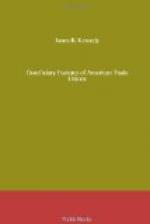A second type is that of the Brotherhood of Carpenters. In their system, death and disability benefits are combined and a benefit is paid on the death of a member’s wife. The benefits are graded but the maximum amounts are not large. The following table shows the system as a whole:
Beneficiary system of
the brotherhood of carpenters.
=====================================================
Member’s Death | Wife’s Death |Disability
Benefit. | Benefit. |Benefit.
-----------------------------------------------------
$100 on 6 months’| $25 on 6 months’| $100
on 1 year’s
membership. | membership. | membership.
| |
$200 on 1 year’s | $50 on 1 year’s | $200
on 2 years’
membership. | membership. | membership.
| |
| | $300 on 3 years’
| | membership.
| |
| | $400 on 4 years’
| | membership.
-----------------------------------------------------
>
The per capita cost of maintaining this system, adopted in 1882, has varied greatly from year to year. In 1895 it was as high as $2.46, while in 1900 it was as low as eighty-one cents. The explanation of this variation lies in the changes in the number of members and consequent changes in the age grouping. When the membership was at its lowest point in 1895 those who retained their connection with the organization were to a considerable extent the older members who were desirous of keeping their insurance. The number of claims (death, wife’s death and disability) in 1895 was sixteen per one thousand of membership. In 1900 when the membership had doubled the number of claims per one thousand of membership was thirteen and in 1906 it was nine. The average amount of a claim in 1895 was $133, while in 1900 it was $105. In 1906 the average amount of a claim was $125.
Two deductions may be made from these statistics. The Carpenters have heretofore been unable to retain their membership in dull times. The result has been that the death rate has been lower and the average amount of the claims less than it otherwise would have been. The increase in membership in prosperous times results also in decreasing the average amount of the claims, since in such periods the mass of the members have not been long enough in membership to entitle them to more than the minimum benefits. The benefits furnished by the Carpenters and other unions with similar systems of benefits are provided at less than the cost would be in organizations with stable membership. The per capita cost of $1.23 in 1906 is far below the actuarial cost.
The Typographia and the Cigar Makers are typical unions of the third and final class. In these organizations there are highly developed beneficiary systems. The members receive not only death benefits but out-of-work and sick benefits. In both unions the membership is stable. In the Typographia periods of depression and prosperity do not affect the number of members. In the Cigar Makers the increase in members is checked in hard times but no decrease is suffered. In such unions the per capita cost of the death benefit is not lowered by lapses to any appreciable extent.




